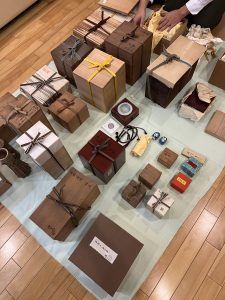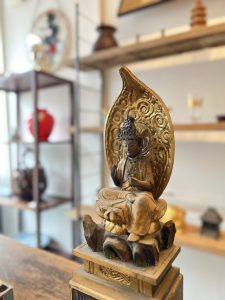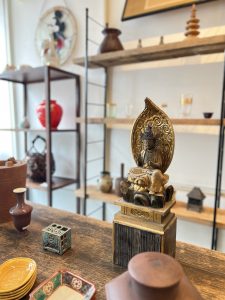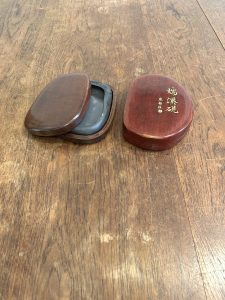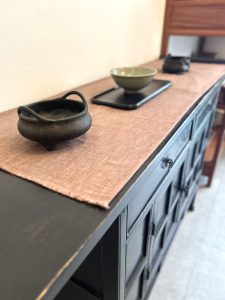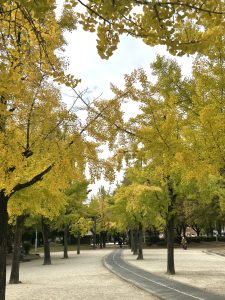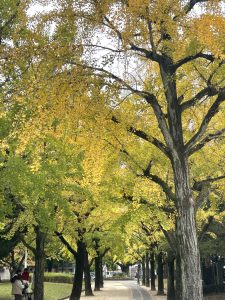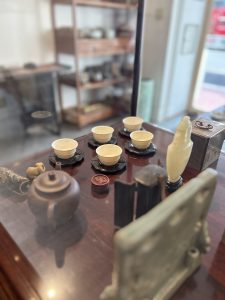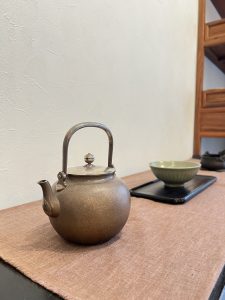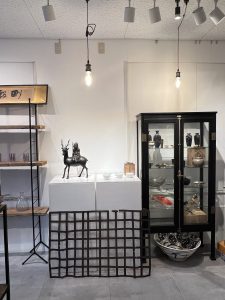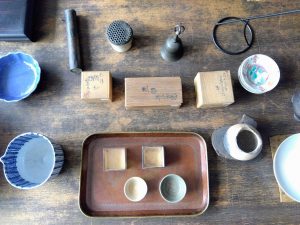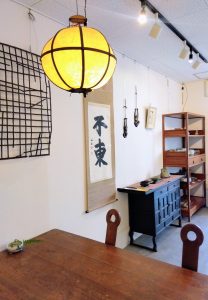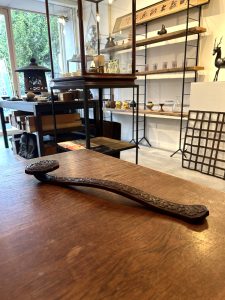遺品整理や生前整理など実家やご自宅のお片付けや買取などでご相談が一番多い御品は「掛軸」でしょうか。
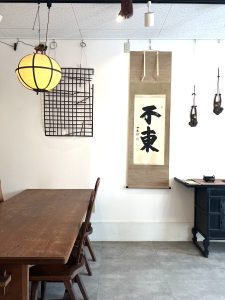
かつての住まいには和室に床の間のしつらえがあるお宅が多くございましたが、現在では床の間の無いお宅も多くなり掛軸を飾る機会も少なくまりました。遺品整理をされるご親族の方も価値がよくわからないという方もおいでですので、その価値を知るうえでも、本日は「掛軸」を鑑定・売却される際のポイントをあげていきたいと思います。今後のお片付けのご参考になさってみてください。
1.共箱などの付属品はありますか?
共箱とは作者が署名捺印した掛軸の収められている箱のことです。桐製の箱などで納められることが多く、箱の表側には作品名が記載されており、裏側に作者の名前が書いてあるのが一般的です。(作者によっては、違う場所に署名捺印がされていることも)高額査定となる可能性がありますので、廃棄せず掛軸と一緒に保管しておきましょう。
2.二重箱がある場合も
二重箱は掛け軸を直接収納する共箱に加え、さらにその桐箱を収めるための外箱が備わった二重構造の箱のことです。その目的は主に保護効果と美観にありますが、多くは湿気を防ぐ漆が塗られた塗り箱になっております。二重に保護されることで内部の湿度が一定に保たれやすい構造になっており、これらに収められている掛軸は、高額査定となる可能性もありますので大切に保管しておきましょう。
3.鑑定書がある
鑑定書が付属された掛軸や、鑑定士が真贋を判定して鑑定書を発行したものは高額査定となる可能性が高いうえに査定もスムーズになりますが、時代の古い掛軸などは鑑定書の無い場合もあります。その場合、以下のような真贋を判断するためのポイントがいくつかございます。
・作家の落款や署名
・肉筆か印刷か
・画風やモチーフ(題材)
・鑑定書の有無や入手ルート
いずれの場合もその価値を素人が判断するのは容易ではありませんので、専門家や専門の業者へ査定を依頼することがご安心かと思われます。
4. 傷や汚れがない
掛軸は傷や汚れがないことが鑑定や売却の際も大切になってきます。保管環境の影響を受けやすいため細心の注意を払って管理しましょう。傷や汚れ、経年劣化があると査定価格が下がってしまうことがありますので、しばらくはご自分で保管したい場合は、二重箱に入れて保管する場合も湿度の高い場所は避けることが重要です。さらに、湿気は掛け軸の大敵ですので、年に1、2回を目安に直射日光が当たらない風通しの良い場所で日陰干しを行うとより掛け軸を長持ちさせられます。
5. 価値の高い掛軸とは
気になることころがお持ちの掛軸の価値でありますが、鑑定のポイントはおおよそ以下のような点があげられます。
・著名な作家が手掛けている
・古い年代に制作されている
・保存状態が良い
・中国で制作された掛け軸
鑑定時には著名な作家などの情報、制作年の古さ、現存数の希少性など少ないほど高まりますが、保存状態の良さもおおいに影響します。また、一部のコレクターには中国の掛け軸が好まれる傾向にあり、素人による判別は簡単ではないですので、いずれの場合も専門家や専門の業者での鑑定が望ましいと思われます。
6. どのような状態でも売却は可能です
以上のような条件をお伝えしましたが、共箱・二重箱などに保管されていない、シミや傷がある、作家の落款や署名がない、価値がわからないなどの掛軸も売却買取はもちろん可能でございます。いずれの場合でもその価値を確かめることは大切ですので、ご相談は専門の業者への依頼をおすすめいたします。

古美術風光舎では掛軸の鑑定・買取のご相談など無料で行っておりますのでお気軽にご相談くださいませ。
それではごきげんよう(スタッフY)
Among the most common items we receive inquiries about during estate cleanouts, pre-death organization, or home cleanouts and purchases are hanging scrolls.
In the past, many homes had a tokonoma alcove in their Japanese-style rooms. However, nowadays, many homes lack a tokonoma, reducing opportunities to display hanging scrolls. Some relatives handling estate cleanouts may not fully understand their value. Therefore, to help you understand their worth, today we will outline key points for appraising and selling hanging scrolls. Please use this as a reference for future cleanouts.
1. Are there any accessories like a coffin box?
A coffin box is the box that holds the hanging scroll, signed and sealed by the artist. It is often made of paulownia wood. Typically, the front of the box displays the work’s title, while the back bears the artist’s name. (Some artists may place their signature and seal elsewhere.) Since this can significantly affect the appraisal value, keep it stored with the hanging scroll instead of discarding it.
2. Presence of a double box
A double box refers to a two-tiered structure: the main box (the coffin box) that directly holds the hanging scroll, plus an outer box designed to contain this paulownia box. Its primary purposes are protection and aesthetics. Often, the outer box is a lacquered box coated with moisture-resistant lacquer. This double protection helps maintain stable humidity inside, potentially increasing the appraisal value of scrolls stored within. Keep these boxes carefully.
3. Presence of an Authentication Certificate
Hanging scrolls accompanied by an authentication certificate, or those where an appraiser has verified authenticity and issued a certificate, are more likely to receive high appraisals and undergo smoother appraisal processes. However, older hanging scrolls may lack such certificates. In such cases, several points can help determine authenticity:
・The artist’s seal or signature
・Whether it is hand-painted or printed
・The painting style and motif (subject matter)
・The presence or absence of an appraisal certificate and the acquisition route
In any case, it is not easy for a layperson to judge its value, so it is advisable to request an appraisal from an expert or a specialized dealer for peace of mind.
4. Absence of Damage or Stains
The absence of damage or stains on a hanging scroll is crucial for appraisal and sale. As they are susceptible to storage conditions, manage them with utmost care. Damage, stains, or signs of aging can lower the appraisal value. If you wish to store it yourself for a while, placing it in a double box and avoiding humid locations is crucial. Furthermore, moisture is the arch-enemy of hanging scrolls. Air-drying them in a well-ventilated, shaded area (avoiding direct sunlight) once or twice a year will help prolong their lifespan.
5. What Constitutes a High-Value Hanging Scroll
You may be curious about the value of your own hanging scroll. Key appraisal points generally include the following characteristics:
・Created by a renowned artist
・Produced in an older era
・In excellent condition
・Hanging scrolls produced in China
During appraisal, factors like the artist’s fame, the age of production, and the rarity of existing pieces (fewer existing pieces generally increase value) are important, but the scroll’s condition also significantly impacts its value. Additionally, some collectors tend to favor Chinese hanging scrolls, and distinguishing them can be difficult for non-experts. Therefore, in any case, appraisal by a specialist or professional dealer is advisable.
6. We can sell items in any condition
While we’ve outlined the above conditions, we can certainly sell hanging scrolls that are not stored in their original boxes or double boxes, have stains or damage, lack the artist’s seal or signature, or whose value is unknown. In any case, confirming the value is important, so we recommend consulting a specialist for appraisal or sale.
At Fūkosha Antiques, we offer free consultations for hanging scroll appraisals and purchases. Please feel free to contact us.
Take care (Staff Y)
*******************
ご実家の整理やお片付けなどをされている方のご相談などが多くございます。
お片付けなどくれぐれもご無理のないようになさってくださいませ。
風光舎では古美術品や骨董品の他にも絵画や宝石、趣味のお品など様々なジャンルのものを買受しております。
お片付けをされていて、こういうものでもいいのかしらと迷われているものでも、どうぞお気軽にご相談下さいませ。
また風光舎は、出張買取も強化しております。ご近所はもちろん、愛知県内、岐阜県、三重県その他の県へも出張いたします。
まずは、お電話お待ちしております。
愛知県名古屋市千種区姫池通
骨董 買取【古美術 風光舎 名古屋店】
TEL052(734)8444
10:00-18:00 OPEN
